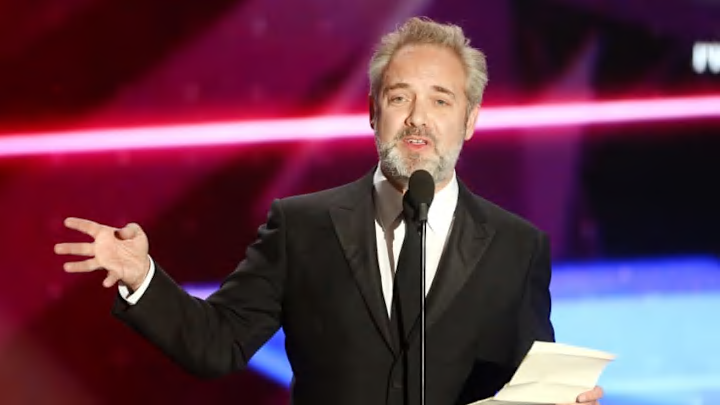Sure, we should “never say never,” but with Sam Mendes taking on new projects, it certainly seems that he will never direct another James Bond film. Given that, in what ways has the Oscar-winning director left an impact on the franchise? Let’s explore that question.

The Films
Mendes was the first director to film back-to-back Bond films since John Glen, with The Living Daylights and Licence to Kill. Like Glen, his fingerprints are all over his films…and there is even a slight nod to Glen in one of them.
For starters, both Skyfall and Spectre benefit from rich visuals, particularly in stunning aerial shots. Cinematographers Roger Deakins (Skyfall) and Hoyte Van Hoytema (Spectre) are in top form: the Shanghai skyline at night, Bond and M’s drive through the Scottish countryside, and Bond’s boat ride to see Mr. White are just a few examples.
Mendes also liked to square his shots, with a lot of right angles. This is evident in many instances in both films. A good example: Bond’s toast to Severine’s guards in the Macau casino. We see Bond from behind, upright. He is centered in the shot, raising his martini glass. Aside from two circular symbols at the end of the bar, the casino is made up of railings, light fixtures, and wall panels that create patterns of perpendicular and parallel lines.
As for symbols, look no further than the mirror. They’re everywhere in Mendes’s two Bond films–we see a lot of Bond looking at his own reflection. Mirrors even play a prominent role in the title sequences. And all of this makes sense, given that Mendes appears to explore Bond’s psychology in Jungian terms: the duality of man, the attempt to emerge from the shadow self. (See “Psychoanalysis” below).
And as for that nod the Glen? Check Spectre: the birds that spring up and fly toward Bond in Mr. White’s house in Austria. Glen was known for having pigeons spring up, out of nowhere.
Q and Moneypenny
For decades we had known Q as a cagey old veteran, played by Desmond Llewelyn. When Ben Whishaw came on board, he represented a fresh (and realistic) approach to the type of agent that would run Q Branch. Bond appears as taken aback as the audience is. In Skyfall, when the two meet at the National Gallery, Bond quips, “Youth is no guarantee of innovation.” But Whishaw’s Q is not just “young;” he is also witty, as demonsrated by his comment to Bond in Spectre:
"I told you to bring it (the DB5) back in one piece, not bring back one piece."
Meanwhile, during all those years, Moneypenny had mostly been behind a desk outside M’s office. Her flirtations with Bond were mere playfulness. But Naomie Harris brought something new to the role of Moneypenny when the character was reintroduced to the franchise. Tough and sexy, this new Moneypenny can handle a rifle as well as a razor. And she and Bond may now have a romantic past, as suggested by their encounter in Bond’s Macau hotel room.
A-List Villains
Through 22 Bond films, Christopher Walken (in A View to a Kill) was the only Oscar-winning actor to tackle the role of a Bond villain. But in his two films at the helm, Sam Mendes presented two more: Javier Bardem and Christoph Waltz.
Bardem’s transformation into the platinum-haired Silva earned him a Screen Actors Guild nomination for Best Supporting Actor. Meanwhile, Waltz had the unenviable task of taking on iconic villain Ernst Stavro Blofeld, and opinions vary greatly in terms of his performance.
Music
Mendes’s two Bond films produced two Oscars for “Best Original Song.” Both were classic-sounding Bond songs, with rich orchestral accompaniment, but with a modern flair (though some fans found Sam Smith’s falsetto out of place.) Certainly, Adele’s “Skyfall” will go down as one of the greatest Bond songs ever recorded.
With Mendes, along came Thomas Newman, whose style turned out to be a perfect match for two films that emphasized Bond’s past and inner demons. Newman received an Oscar nomination for “Best Original Score” for Skyfall.
Psychoanalysis
Bond films have traditionally been known as escapist entertainment and not much more than that. Though scholarly work has been conducted on the films (and books) for years, none have been as ripe for critical approach as Skyfall and Spectre. As noted, Mendes took a Jungian approach, which makes sense considering the connection between Ian Fleming and Carl Jung. We get our first glimpse of this when Bond meets with an MI6 psychologist, who begins an examination with simple word association. When the word “Skyfall” comes up, a reference to “unresolved childhood trauma,” Bond promptly ends the exam.
The emphasis is placed Bond’s background, as an orphan. In Skyfall, M says, “Orphans always make the best agents.” Later, at the Skyfall estate, Kincade explains how Bond hid himself in an underground tunnel, for days, after his parents died. “When he came out, he wasn’t a boy anymore.” The similarities to Bruce Wayne’s background are unmistakable–and worth a whole other investigation.
In Spectre, Madeleine Swann asks Bond if the life of a secret agent is what he really wants. Bond replies, “I’m not sure I ever really had a choice.” Indeed, as an orphan, recruited by MI6, whose life is he living? This same question was posed to him by Silva, as well. Perhaps, Bond has two paths in life: the one he wants and the one he has been trained to follow.
No wonder Madeleine Swann looks at him, in Tangier, and says, “There are two of you. Two Jameses.”
